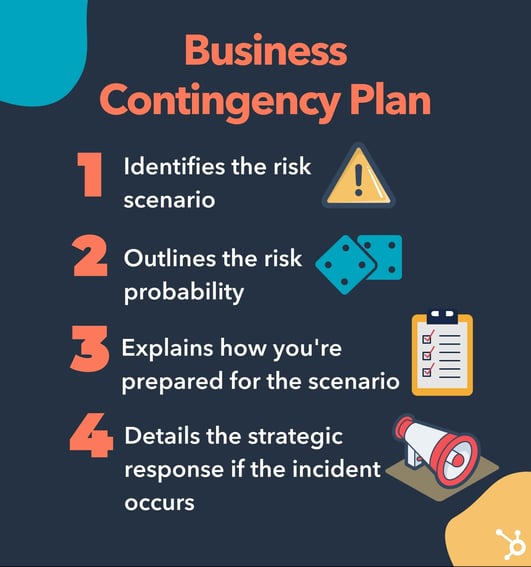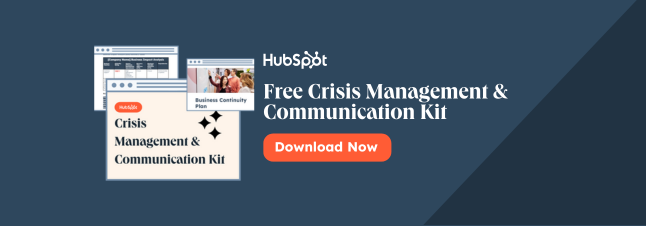Objectives to Be Followed When Conducting Network Continuity Planning
The COVID-19 pandemic has shown, more than ever, the importance of being prepared for the unexpected, especially when it comes to business continuity. While some unexpected interruptions can be due to situations outside of your control, some issues arise that may be caused by internal errors. Unexpected problems can also be positive, like a sudden influx of interest in a new product. Regardless of the scenario, it's essential to prepare for everything, and contingency planning helps you do so. This post will explain what contingency planning is, outline the steps you can follow to create your own plan, and give examples that you can use for inspiration. Contingency planning is a proactive process of creating a strategy to help you prepare for any scenario that can affect your business, regardless of the likelihood of its occurrence. These plans shouldn't focus solely on situations that may harm your business. For example, you may experience a significant increase in revenue during a specific period due to changes in market behavior. This is a good scenario, but you will still need to adapt your operations to scale and appropriately meet the new demands of your growing audience. Contingency planning is also different from crisis management, as it is not a reaction to something that has already happened but more so a plan for if and when something may happen. However, a contingency plan can help you with crisis management when issues arise. To ensure your business is prepared for everything, it's crucial to understand how to create a contingency plan. A business contingency plan is a strategy that outlines the steps your business' teams will take in the event of a crisis occurring. It is essentially the backup plan that goes into action when the worst-case scenario occurs. The goal of your contingency plan is to help your business stay up and running after an issue arises. Although their names vary by few letters, business continuity and contingency plans are different concepts. Continuity is the ability of your business to continue functioning after an incident that has disrupted operations occurs. A contingency plan is an action plan that goes into place if an incident were to happen. Contingency plans can significantly impact whether your business can achieve continuity. Being able to react and take action during a crisis can dictate whether or not your business can emerge from the other side and continue normal business operations. You can think of it like this: your continuity plans contain five sections: program administration, governance, business impact analysis, strategies and requirements, and training and testing. If your business also uses contingency plans, it could be part of the strategies and requirements section, which dictates how your business will respond to a crisis if it occurs. To ensure your business is prepared for everything, it's crucial to understand how to create a contingency plan. Creating a contingency plan is responding to the question of "What if?" What if your storefront floods? Or what if your supplier goes out of business? The responses to the what-ifs are contingency plans. These scenarios aren't necessarily going to happen, but if there is a possibility that they'll affect your business, you're prepared if they do. Below we'll discuss the steps that go into contingency planning. This first step is the most important aspect of your planning, as it sets the tone for why your plans need to exist in the first place. During this phase, identify all critical areas essential to keeping your business up and running every day. As these operations are imperative to success, you need to have plans to ensure that these operations continue, regardless of whatever scenarios arise. You can think of it like this: these critical areas keep your business up and running on a day-to-day basis. Other areas are important, but these are the main functions that keep you afloat. Given this, you want to be prepared for anything and everything that may happen that can affect the critical areas, whether positive or negative. Contingency planning is exactly that. Identifying these areas helps you move on to the next step as you begin brainstorming possible scenarios that can impact them. Once you've identified the critical operations of your business, you'll want to conduct a scenario assessment to identify situations that will affect these functions and put stress on your day-to-day operations. For example, if your business operates out of a storefront, keeping your storefront up and running is a critical area of your business success. Maybe you launch a new product that attracts more interest than you thought, and you need to deal with higher in-store traffic and a lack of products to satisfy the market. While it is a positive situation that will draw in more revenue, it can still have negative repercussions for your business if you don't deal with it when it happens. You can think of this stage as similar to a risk assessment, but the possibilities are positive and negative. It may be helpful to meet with people who work in these critical areas and understand what they think may cause interruption to their job duties and barriers to their success. Ask them how they feel situations will impact them and how they would deal with each scenario. If you come up with a long list of threats, you can prioritize them based on their likelihood of occurring and how significant their impact would be on your business. During this phase, you'll create contingency plans. Begin with the highest priority "threats," or those most likely to occur and most likely to cause significant stress to your business. Outline the scenarios, people to inform, and the roles and responsibilities involved parties will have when they respond. We'll go over an example below, but a helpful template to follow can be: Once you've created your plans, distribute them to key stakeholders in each scenario, so everyone understands what they are responsible for and can prepare ahead of time. As with all plans, it's essential to continuously test and update them over time. As businesses scale and change, your business needs will likely change, and specific scenarios will no longer have as significant of an impact. There may also be new scenarios to plan for that you hadn't anticipated or thought of when you were a smaller operation. It can be helpful to create a timeline that you'll use to spend dedicated periods reviewing your plans, testing them, and communicating with the necessary stakeholders about any changes you've made to the plans. As planning is always an involved process, you may be wondering how much time you should devote to each step. Let's discuss a timeline below. Give yourself about a week to identify the operational areas that are essential for business function. You likely already know what these areas are, but you want to do enough research to identify them all. Take two to three weeks to brainstorm the scenarios you're going to create plans for. Spend as much time as possible speaking to the necessary stakeholders to understand their ideas about the scenarios and how they'd like them dealt with. You'll want to conduct probability assessments and market research to understand if your competitors have ever dealt with something similar. You want to make sure you have all the necessary information before drafting your plan, so this step should be the longest. Give yourself a week to draft your plans. The first two steps should give you all the information you need, so the third step is simply fine-tuning your research and creating the final plan. You can also share what you've created with your stakeholders and iterate on what you have based on their feedback. The final step to creating your plan, maintaining and testing, is a continuous effort. As mentioned above, your business will likely be impacted by different things at different times, so it's always important to review plans and ensure they still relate to your needs. For example, maybe you plan to do quarterly reviews and training so new hires, and existing employees, are all on the same page. It may be helpful to have an example of a contingency plan, so we'll go over one below. The examples are of a positive and negative situation, so you can get a sense of how a plan applies to both. Please note that the italicized text is for explanation purposes to further clarify each section. Network Failure Sometimes unpredictable and difficult to control, network failures are common risks to every business. High Network failures are not uncommon. They can be caused by internal error or unpredictable external factors, like severe weather. IT teams have access to secondary networks should primary network failure occur. If it is a result of an external error, teams know who they need to contact. All data is backed-up and available on offline networks so the business can continue running if transfer to the secondary network is needed, and so nothing is lost should the network crash. Marketing and customer-facing teams draft communications that will be sent to customers should issues arise, letting them know that there are service interruptions but people are still available to help. IT teams immediately switch over to secondary networks, and alert all employees as soon as possible. They continuously work to restore original networks, or work with necessary external parties. Communication is sent to customers to notify them of possible interruptions and service people communicate issues with customers when receiving calls. They continue to work to solve customer issues, but let them know that it may take longer than normal to reach resolution. When primary network connection is restored, all employees are notified, as well as all affected customers. Largest competitor goes out of business. This is a positive scenario, as it could mean you have the opportunity to quickly draw in a new target audience that was once loyal to your competitors. However, you would likely be aware ahead of time if this were to occur, as most businesses are in periods of decline before they officially close their doors. Medium Markets are volatile, there's no way to anticipate whether something like this will happen, but some businesses face more struggles than others and, as a result, must close down or minimize their operations. Marketing teams use social listening to discover new clients that may be interested in moving over and have copy available to reach out to those customers, whether via social media, email, or in-person. Having plans to hire and onboard more team members in anticipation of larger business operations. Marketing targets new audiences and attempts to draw in new customers. Recruiters hire and onboard more workers to ensure that there is enough staff to handle larger business operations. All in all, contingency plans help you prepare for a host of what-if scenarios, whether they happen or not. As you never want to be caught in a challenging situation, being prepared is the best thing you can do to ensure your business continues to succeed, regardless of whatever happens along the way. As the saying goes, better safe than sorry. 

What is contingency planning?
What Is a Business Contingency Plan?
Business Continuity Plan vs. Contingency Plan
Contingency Planning: How to Make a Business Contingency Plan
Contingency Planning Steps
1. Identify critical business functions.
2. Conduct a scenario assessment.
3. Create contingency plans for each scenario.
4. Test your plans.
Contingency Planning Timeline
Contingency Planning Example

scenario risk probability Preparation Response 
Source: https://blog.hubspot.com/service/contingency-planning
0 Response to "Objectives to Be Followed When Conducting Network Continuity Planning"
Post a Comment